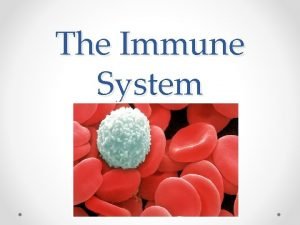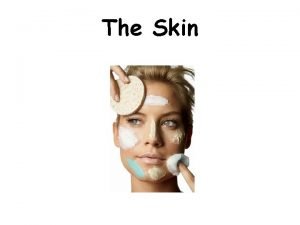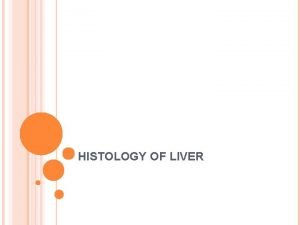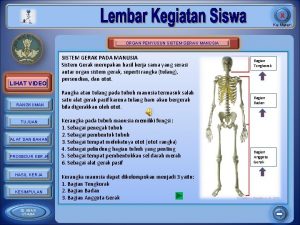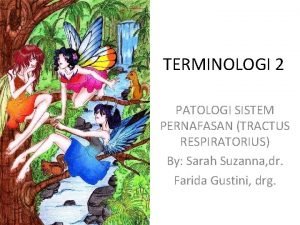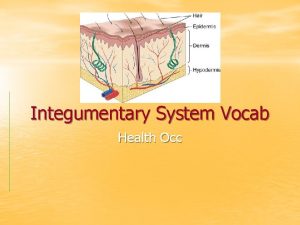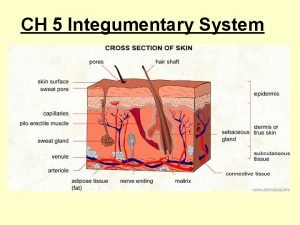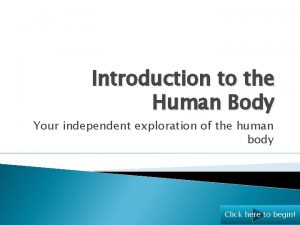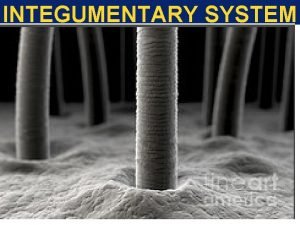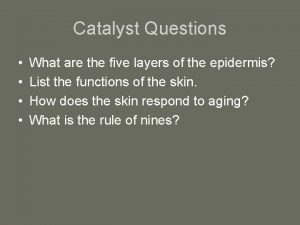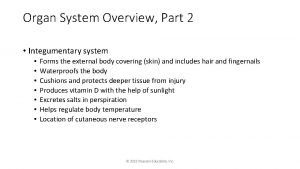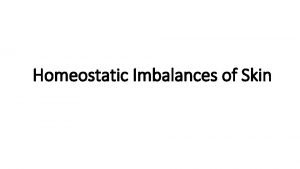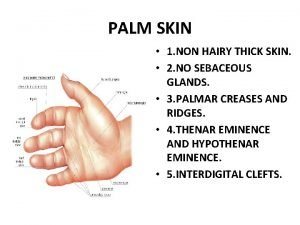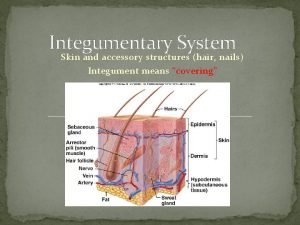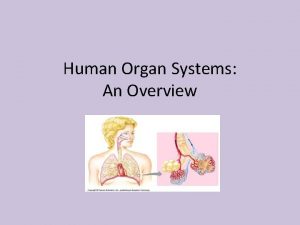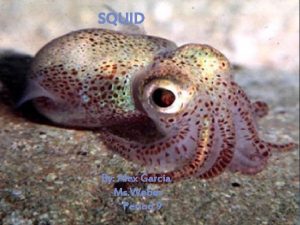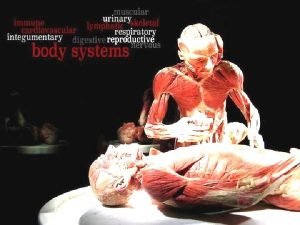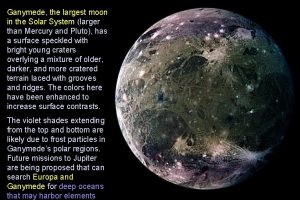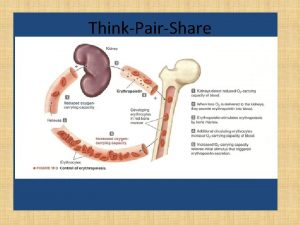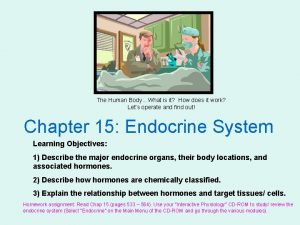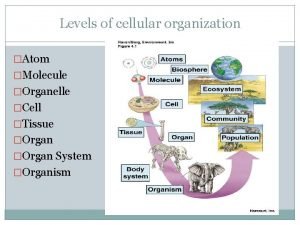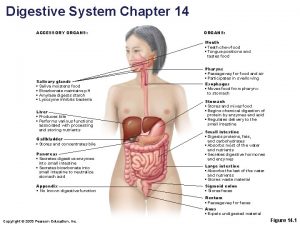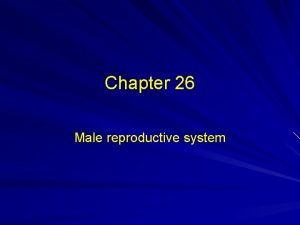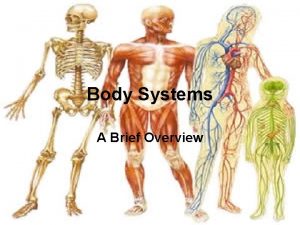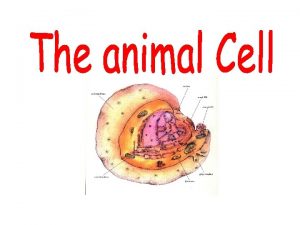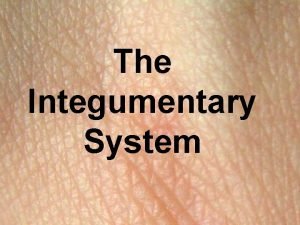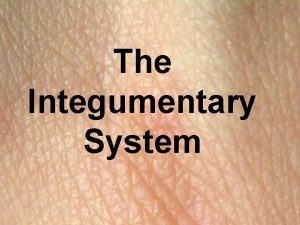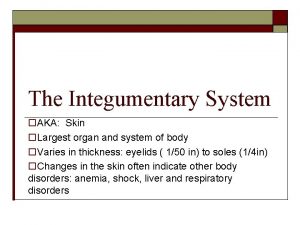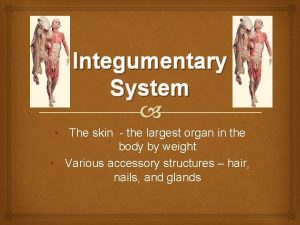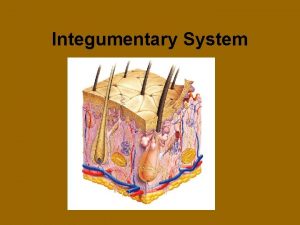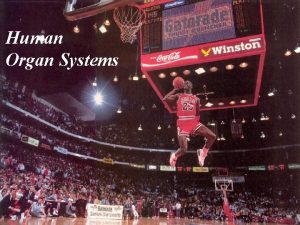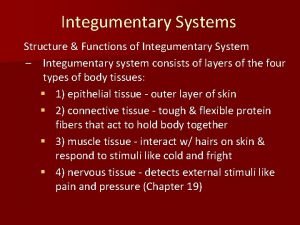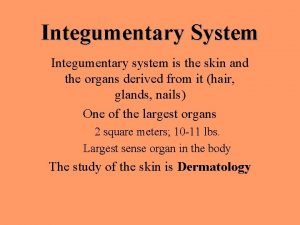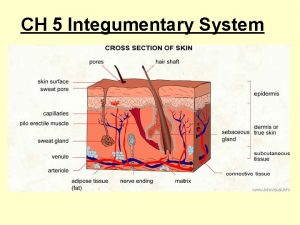Integumentary System Skin skin is the largest organ































































- Slides: 63

Integumentary System : Skin skin is the largest organ in the body. Also included are the accessory organs: hair, sweat glands, sebaceous glands, nails and variations

Skin: The study of skin is dermatology. The skin has a variety of functions including: *barrier against invasion of micro-organisms *protects underlying structures from injury *prevents the body from drying *inhibits excess water intake (from aquatic species) *regulates temperature *receptor for sensations of touch, heat, cold, pressure and pain. *disposal of waste products

The body produces heat by metabolizing ingested food and the amount of heat produced is the result of the amount of work done by the muscles. Most of body heat is lost by:

Radiation: heat energy is transmitted as rays to the surrounding areas.

Conduction: heat energy passes by direct contact through a non-moving medium. Eg: when an animal lies on a cold surface it loses heat directly to that surface. Or when an animal is lying on a surgery table the heat is lost directly to the surface of the table and through the incision made

Convection: heat transfer occurs in a gas or liquid by the circulation of currents from one region to another. This is the heat loss responsible for the wind chill factor

Evaporation; heat is lost as perspiration or other fluids on the skin. Air currents can increase evaporative heat loss through convection.

Most of the remainder of heat loss occurs through mucous membranes and lesser amounts lost through digestive and urinary tracts

Composition of skin the skin is composed of two layers: the epidermis: outer, thinner layer the dermis: the thicker inner layer

dermis epidermis


The Epidermis: is made up of stratified squamous epithilial tissue, the layers from the dermis outward are

Stratum germinativum: (basal layer) The cells in this inner most layer multiply continuously to compensate for the constant loss of cells from the surface of the epidermis. These cells push upward into each layer and eventually die.

Stratum spinosum: (spinous layer) The cells begin to shrink and draw apart. This layer is only one or two cells thick. It is thicker on parts of the body that endure rugged wear (footpads)

Stratum granulosum: (granular layer) The cells in this layer contain granules visible in the cytoplasm. This layer may not be present in some areas of thin skin. Keratinization or cornification packs the cells with fibrous protein called keratin



Stratum lucidum: (clear layer) This layer is made up of closly packed clear cells. This layer is found in tissue that endure rugged wear.

Stratum corneum: (horny layer) This layer is made of flat lifeless cornified cells. They appear as overlapping dry scales that make up the outer skin layer. If unbroken, they will prevent the entrance of microorganisms. Keratinization gives the special epidermal parts (hooves, horns, beaks) their strength.

Cornified


Skin color is determined by the amount of melanin in the stratum germinativum layer. Heredity, the sun and some hormones affect the skin color



The absence of normal pigmentation is called albinism. True albinism prevents pigmentation of the skin, hair and eyes. This condition may be associated with other lethal traits as well as a lack of protection from the sun


Skin color can also be affected by the blood supply. Eg. Skin color can take on a blue hue (cyanosis) when oxygen supply is compromised


The dermis (corium) is made up of dense, fibrous connective tissue containing blood vessels and nerves. Small involuntary muscles (arrector pili) are attached to the hair follicles. When these muscles contract, the hairs stiffen. This increases the animals ability to insulate itself against cold.



Sebaceous glands, sweat glands, sensation receptors are found in the dermis layer.

The subcutaneous layer under the dermis is the hypodermis or subcutis. It consists of loose connective tissue and adipose tissue.

Skin structure differs throughout the body. It is tough, stretchable and varies in thickness.

Hair Mammals have three types of hair. *primary *secondary *tactile

Primary hairs are also called guard hairs and these make up the top coat. These hairs are stiff with a smooth appearance. This arrangement allows rain to run off the coat preventing chilling of the animal



Secondary hairs are also called wool hairs and make up the undercoat. These hairs are soft, thin and wavy.


Tactile hair are usually thicker and longer than primary hair and is most often found about the face. These hairs grow deep from the hypodermis or superficial muscle layer and act as a touch receptor.


Hair develops from the hair papilla, located at the base of the hair follicle. Cells at the base increase, push upward and keratinize forming the visible hair shaft. Hair follicles are positioned at 30 – 60 degree angle to the skin.

The two arrangements for hair growth: simple: primary hairs grow from separate follicular openings complex: two to five guard hairs erupt from a single follicle.

Hair color is important for thermal regulation. In general, lighter color coats are cooler. Animal hair grows in cycles. Factors affecting the shedding cycle: temperature, nutrition, hormones, genetics, state of health.

Sweat glands are excretory organs of the skin that cool the body. Apocrine sweat glands are found throughout the body and secrete a strong smelling substance in the hair

Eccrine sweat glands are coiled tubular structures embedded in the dermis and produce a watery sweat. These glands are found in limited areas usually the footpads and nostrils

The sebaceous glands secrete a substance called sebun which lubricates the skin and hair, waterproofs the coat, gives the coat a glossy sheen, increases the spread of sweat, slows bacterial growth, and serves as a territorial marker. Examples of these glands are:


Circumoral glands: These glands are found in the lips of cats. During grooming or when a cat rubs it’s head against and object, the secretion is deposited to mark territory


Horn glands: These glands produce a musk odor that attracts females to males during breeding season. They are located caudo-medially to the horn base.

Anal sacs: These are cutaneous pouches that express a foul smelling fluid that is expressed during defication and is used as a territorial marker.


Ceruminous glands: These are classified as modified sweat glands. They are located in the external ear canal. It excretes a yellowish waxy substance called cerumen (earwax)

Nails, Claws and Hooves. All three of these structures have the following parts in common: *wall *sole *pad

In primates the nail is the wall and it grows from the epidermis. The sole is located beneath the nail at the open end. The pad corresponds with the finger tips


In carnivores the claw is the wall, which has been compressed laterally. The sole is the underside of the wall and is flaky in texture. The pad corresponds to the foot pads


Plantigrade animals have well developed footpads. Digitigrade animals include cats and dogs. Only the digital and metacarpal pads make ground contact Ungulates include hoofed animals

The hoof is the wall, the sole is the underside of the hoof, the footpad is the bulb or heel.

Dewclaws, chestnuts and ergots are modified epidermal structures. In the dog and pig, the dewclaw has a rudimentary bone. In ruminants the dewclaws are like miniature hooves and they serve no practical purpose
 Thick or thin skin
Thick or thin skin Cell tissue organ organ system organism
Cell tissue organ organ system organism Tissues group together to form
Tissues group together to form Organ and organ system
Organ and organ system Largest lymphoid organ
Largest lymphoid organ Lymphatic system organs and functions
Lymphatic system organs and functions Stratum basale
Stratum basale What is the largest organ in the body
What is the largest organ in the body Which is the largest organ in our body? *
Which is the largest organ in our body? * Acinus of liver
Acinus of liver Bodys largest organ
Bodys largest organ Jenis organ penyusun sistem rangka manusia
Jenis organ penyusun sistem rangka manusia Tractus respiratorius
Tractus respiratorius Sistem koordinasi
Sistem koordinasi Epidermis
Epidermis Integumentary system vocabulary
Integumentary system vocabulary Integumentary system of swine
Integumentary system of swine Organum germinativum
Organum germinativum Integumentary system facts
Integumentary system facts The integumentary system exercise 7
The integumentary system exercise 7 Integumentary system abbreviations
Integumentary system abbreviations Integument medical term
Integument medical term The integumentary system
The integumentary system Integumentary assessment
Integumentary assessment Integumentary system analogy
Integumentary system analogy The integumentary system
The integumentary system The integumentary system
The integumentary system Figure 5-1 the components of the integumentary system
Figure 5-1 the components of the integumentary system Effects of aging on the integumentary system
Effects of aging on the integumentary system Section 36-3 the integumentary system
Section 36-3 the integumentary system Integumentary system
Integumentary system Integumentary system
Integumentary system Unit 3 integumentary system
Unit 3 integumentary system Different homeostatic imbalances in the skin
Different homeostatic imbalances in the skin Papillary layer of dermis
Papillary layer of dermis 6 functions of the integumentary system
6 functions of the integumentary system Integumentary system psoriasis
Integumentary system psoriasis Interesting facts about urinary system
Interesting facts about urinary system Integumentary system
Integumentary system Integumentary system
Integumentary system Integumentary system cpt coding guidelines ppt
Integumentary system cpt coding guidelines ppt Stratum basale
Stratum basale Integumentary system of vertebrates
Integumentary system of vertebrates Nails integumentary system
Nails integumentary system Integumentary system
Integumentary system Excretory and integumentary system
Excretory and integumentary system Squid integumentary system
Squid integumentary system Integumentary system foldable
Integumentary system foldable Chapter 6 integumentary system
Chapter 6 integumentary system Thin skin vs thick skin
Thin skin vs thick skin Milady facial massage steps
Milady facial massage steps Ganymede moon
Ganymede moon Chapter 36 skeletal muscular and integumentary systems
Chapter 36 skeletal muscular and integumentary systems Pacinian corpuscle histology
Pacinian corpuscle histology How to pronounce integumentary
How to pronounce integumentary Integumentary interactions with other systems
Integumentary interactions with other systems The human bodywhat is an organ system?
The human bodywhat is an organ system? Atom molecule cell
Atom molecule cell Function of mouth in digestive system
Function of mouth in digestive system Primary sex organ of the male reproductive system? *
Primary sex organ of the male reproductive system? * Plant organ
Plant organ Level of organization organ system
Level of organization organ system Major and accessory organs of the digestive system
Major and accessory organs of the digestive system Organ system examples
Organ system examples




